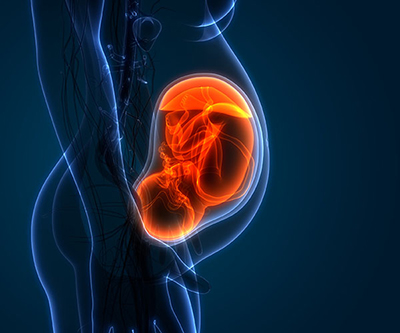
Scientific illustration of a fetus in a womb
The placenta is a temporary but important organ. It helps bring nutrients and oxygen to the fetus, removes harmful waste, provides immune protection, and produces hormones to support fetal development. The placentas of mammalian species vary widely, with differences in size, shape, structure, time required to develop, and the degree to which it invades the uterus. These differences likely reflect changes during evolution. However, the extent to which gene expression differs between the placenta of human and other mammals is unknown at a genome-wide level.
To address this gap in knowledge, the Macfarlan Lab conducted a comprehensive interspecies analysis to compare the transcriptional and regulatory landscape between human, macaque, and mouse placentas. The study team identified hundreds of placental genes that are expressed differently among the compared species. These genes may serve as valuable candidates to explore why human placentas are unique and to identify potential ways to improve pregnancy outcomes.
The researchers also identified genetic enhancers that likely derive from endogenous retroviruses (ERV)—ancient components that make up about 10% of the human genome and help facilitate genomic evolution. The study reports on 19 ERV families that are associated with human placental development, including a few (e.g., MER21A, MER41A/B, MER39B) that have known links to placental or immune functions.
Interestingly, the team found that the human placenta has the least conserved enhancers in relation to other tissues, and this difference is likely a reason why the placenta is unique to each species. Overall, clarifying the molecular features of the human placenta helps us better understand human development and evolution.
Learn more about the Genetics and Epigenetics of Development Group: https://www.nichd.nih.gov/about/org/dir/affinity-groups/GED
 BACK TO TOP
BACK TO TOP